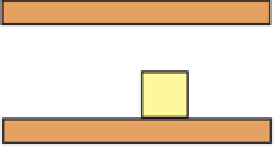Geology Reference
In-Depth Information
Behaviour of materials under
stress
The behaviour of rock material under-
going deformation is dependent on the
inter-relationship between the type of
rock (i.e. its
lithology
), embodying its
physical and chemical composition,
and the physical environment (tem-
perature and pressure) under which
the deformation takes place. It is dif-
ficult for us to imagine a piece of solid
rock being able easily to change shape
because it is outside our everyday expe-
rience, in the same way that we have
difficulty in imagining a solid object
consisting mostly of empty space (as the
physicists tell us!). However, laboratory
experiments help us here in applying
stress to material under artificially high
temperatures and pressures. Moreo-
ver, and critically, by conducting the
experiments for long periods of time,
more geologically realistic conditions
can be approximated, since much of
the deformation whose results we can
see in the real world has taken thou-
sands or millions of years to complete.
the nature of the strain quickly changes
thereafter if the stress is maintained.
In the case of most types of rock ma-
terial, when a large stress is applied, the
material will fracture after only a small
amount of elastic strain has occurred.
Most materials, including rock,
when subjected to a high enough
stress, exhibit permanent deforma-
tion - i.e. the strain does not disappear
when the stress is removed. This type
of deformation is called
plastic strain
and can be simulated by bending a
piece of plasticine or putty, or a thin
sheet of metal. In the case of the metal,
some elastic strain will take place
first, but eventually, with an increase
in the stress, or even by applying the
stress for long enough, plastic strain
will occur. Ideal plastic strain can be
demonstrated using the analogy of an
object, such as a block of wood, being
pulled along a rough surface (Figure
4.10B). After an initial force is applied
to overcome the friction, steady plastic
strain is achieved by applying this force
4
26
27
spring
applied
force
applied
force
strain
strain
A
elastic strain
B
plastic strain
piston
failure
R
visco-elastic
strain
Q
Elastic, plastic and viscous behaviour
The best way to understand how rock
material deforms is to first consider the
behaviour of familiar materials under
stress. Thus the behaviour of a piece of
rubber or a spring when extended is said
to be
elastic,
and in this type of strain
the material returns instantly to its ori-
ginal shape when the stress is removed.
Ideal elastic strain can be represented
by the amount by which a spring, say,
has been extended, and is proportional
to the force that is applied to the spring
(Figure 4.10A). Rock material can also
exhibit an element of elastic strain when
a stress is initially applied, although
strain
P
applied
force
strain
t
ime
C
viscous strain
D
creep
Figure 4.10
A.
Ideal elastic strain is represented by an applied force extending a spring; the amount
of strain equals the amount by which the spring has been extended; there is a steady (linear) increase
in strain with increase in stress and a steady increase in strain with time at constant stress.
B.
Ideal
plastic strain is represented by a block being pulled by an applied force along a rough surface,
opposed by sliding friction; the strain is represented by the distance travelled by the block; the
frictional resistance represents the yield stress; the strain increases without any increase in stress.
C.
Ideal viscous strain is represented by a piston, drawn through a cylinder by an applied force,
the strain being represented by the distance travelled by the piston; the force is opposed by the
resistance caused by the viscosity of the fluid in the cylinder; there is a steady (linear) increase of
strain-rate with stress and strain with time, at constant stress.
D.
Visco-elastic behaviour and creep:
strain-time graph showing a more realistic curve of variation of strain with time, known as a creep
curve; initial visco-elastic strain is followed at P by a period of steady-state strain increase (viscous)
followed in turn at Q by a period of accelerating strain ending in failure (R).



























Search WWH ::

Custom Search